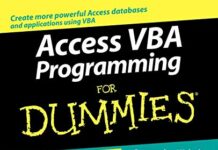
Ebook Info
- Published: 2004
- Number of pages: 408 pages
- Format: PDF
- File Size: 7.45 MB
- Authors: Dee-Ann LeBlanc
Description
This friendly guide gives Linux newcomers the lowdown on how to install and use Linux on the desktop-and join the worldwide community of twenty million Linux usersShows how to get up and running with the latest versions of Red Hat Linux as well as two other popular Linux distributions: Mandrake and SuSECovers prepping a computer for Linux, booting and stopping Linux, connecting to the Internet, surfing the Web, using e-mail, working with cool Internet tools, and manipulating files and directoriesNow revised with enhanced coverage of the OpenOffice.org Desktop Productivity Suite.Includes a DVD that contains all of the CD-ROMs that make up the full Fedora Core Distribution, including the source code.
User’s Reviews
Editorial Reviews: From the Back Cover Set up a great Linux system–no experience needed! Compare distributions, use Linux multimedia tools, and check out OpenOffice.orgReady to explore the wonderful world of Linux? This is the place to start! Just follow the advice in this handy guide, and in no time you’ll have your personalized Linux system installed and configured, know your way around the GNOMETM and KDETM interfaces, be hooked up to the Internet, and start impressing your friends.All this on the bonus DVDFull Fedora Core distribution, including source code, on DVDDiscover how to:Work with popular Linux distributions: Red Hat’s Fedora, SuSE, and MandrakeTM Choose an ISP and configure dialup serviceUnderstand bash command syntaxInstall and use OpenOffice.orgManage the Linux file system About the Author Dee-Ann LeBlanc (Vancouver, Canada) is an award-winning author of numerous books and articles. Dee-Ann develops and teaches courses on Linux, Unix, and other computer-related topics online and in person. She has also presented at various computer conferences.
Reviews from Amazon users which were colected at the time this book was published on the website:
⭐I’m not a serious programmer, but I’ve done some C++ programming and was looking for a dipper look into Linux. Unfortunately this book is about a Windows Type Operating System (Red Hat Fedora) and how to installing it and use it. If you’re are tired of Windows and all its problems this is the book for you.Easy to understand and comes with a DVD with the software
⭐Helped me a lot at the time.
⭐I read LeBlanc’s 4th Edition book to see if it has been improved enough for Newbies. It is not. While including two CDs that have RedHat Linux v8, its installation section is still woefully inadequate with two chapters of 40 pages. For example on p22 the authors say that if you have Dell, Compaq, or HP, you should have no problem. In my experience with Compaq Presarios and HP Vectras, they use custom mobos, BIOSs, chipsets, sound, and win modems that will conflict with Linux. Another example on p31, the authors write 2 inches on video boards and monitors, the Achilles heel for getting the Linux GUI up and running.The authors’ best suggestion (p65) is to get help from a local Linux Users Group; available in large metros; such as Minneapolis which meets monthly at the Univ of Minnesota’s renown Computer Science and Electrical Engineering Dept! How can you get better help than that? They also have a daylong Install-Fest twice a year. I agree that this is the best way, but what about the rest of us (p2) which is this book’s target audience?After researching, reading, and buying a half dozen books on Linux installation, I have yet to see a book that shows a cookbook approach for the Newbie. It would be based upon a reference computer hardware set that has been chosen for it’s popularity and compatible processor, motherboard, cards, and devices. Since one can easily find and cheaply buy used, legacy components on eBay, used computer stores, electronic swap meets, flea markets, and garage sales, installation procedures could be simplified and would be direct and to the point. And be guaranteed to work! It would avoid the tons of frustration and wasted time by reading and attempting to follow all those books and Linux HowTos which are so generalized that Newbies finds them totally confusing and absolutely useless.Case in point, almost all Linux authors (p14) pride themselves that Linux will run on older, legacy hardware, probably what is in their DOS and Windows hand-me-down pile. However for a Newbie, they want to use a modern GUI, not type into a CLI. So in attempting to use this legacy equipment, the Newbie will run into the most common problem, which is carefully not mentioned by Linux writers, that the X-Windows probe for video board and monitor is not very robust compared to Microsoft Windows. Visually identifying chipset models on video boards and finding monitor sync information is one of the most critical items, yet it is rarely emphasized with step-by-step explanations and photos of reference hardware. The Newbie is not shown how to decipher the actual spec listings of popular hardware, locating the important parameters, and ignoring all the rest.Another example is dual boot (p26) Linux along with Windows, a common Newbie configuration. Again almost all Linux authors, including these authors, gloss over the interactivity required on the boot blocks by reconfiguring the MBR with the MSDOS Format command. Wannabe Linux users will find that just because you have a computer working in DOS, WfWG, or Win9X, etc, that it does not translate to a slam-dunk in installing and configuring Linux.The Newbie just isn’t aware of the behind-the-scenes sophistication that Microsoft developed for Windows installs. Overzealous Linux authors don’t warn the Newbie that incredibly more work is necessary to technically understand the details of each component. And if that component manufacturer has gone out of business, then avoid it with a ten-foot pole for his first Linux box.It now comes full circle that a reference hardware installation cookbook is sorely needed. Chapter 4, Installing Other Distributions, includes installation notes for Caldera, Mandrake, SuSE, and Debian, which is superfluous for the Newbie. These 10 pages could have been put to better use with a hardware cookbook because if the Newbie couldn’t get RedHat v8 to install, then (s)he certainly wouldn’t get the others installed either. The install troubleshooting Chapter 18, of ten (10) pages, is woefully inadequate and full of one-liners (jokes). The CLI log-in screen is here in the back (p296); why not in the install section on p62?Back to my purpose in reading these authors’ book, I was expressly trying to find how to switch to the KDE GUI since RedHat’s default GUI install is GNOME. The authors say (p84) that it is easy to switch and they have a Chapter 6 (p86-97) which explains the differences and similarities between the two GUIs. Yet the authors never tells HOW to switch; the Table of Contents, sidebars, icons, 20-page index, were all useless. The RedHat and GNOME Help were useless too.The critical thing that the authors left out was the GUI log-in screen, which had no pix. Although I discovered the secret with RedHat Linux 9 (March 03, Shrike release), the GUI log-in screen has a “Session” button along the bottom row. I had previously ignored them; but lo-and-behold! It is for the GUI startup selection. A serious omission on part of the three authors.An important area that the authors discuss adequately is the systems administrator account and user accounts, explaining that Newbies can crash the system (p98) by an inadvertent keystroke (mouse-click). The Linux OS can be pretty fragile as a root user. But further explanation of the superuser, especially application superusers, and users & groups is not well explained. As listed on p286, important applications that attract Newbies to Linux in the first place, such as a Samba fileserver, an Apache webserver, and MySQL and PostgreSQL databases are not covered at all.And last, but not least, the authors put in another one-liner to install and use a tape backup (p308) because Linux will fail, you just don’t know when. The authors omitted installing a tape drive, neither using the Tar nor Amanda tape backup utility, nor explaining the disaster recovery process. From authors who have umpteen credentials, this last omission is almost unforgivable.
⭐I just bought a cheap computer to exclusively run the Linux OS. After about six hours, I finally finished it. Xwindows looks beautiful and I am quite happy to say that no Microsoft software is presently on my hard drive.Unfortunately, this book succeeded in doubled my time in getting Linux installed. The most useful parts of the book were just reproductions of the Red Hat installation guide that walks you through installation when you boot up the first CD! The book made it seem like I needed to do all sorts of research and voodoo before engaging in such a software-guided installation, but in the end I junked the book and let the Red Had installation software be my guide. Perhaps the authors are Microsoft plants who want people to fail in switching over to Linux.Since half the book is such redundant installation ‘help’, I can’t recommend buying it, with one exception. I give the book two stars because of the CDs: they contain full documentation and source code for Red Hat Linux 7.0, which is very convenient. On the other hand, you can burn all that stuff from the web: this is the land of Linux where everything is free!
⭐In fact I read it cover to cover. And given that Linux is used commercially as a server operating system, and usually by dedicated developers as a front-end, why would edition 5 cover only the “front-end” as the latest author calls it. The trick to covering Linux is covering the operating system and not so much the bells and whistles, unless one wants to wind up writing a legal tome (more than one probably).And come to think of it, I am getting soooo incredibly tired of MS Windows that I am getting sorely tempted to start using Linux as a front-end anyway – so I might be buying the 5th edition of this book someday.
⭐So you have decided to plop down some cash and get a reference book. I hope thats all you want from this, because like many other books, the software that comes with it may or may not be worth it. As the other reviewers stated installing linux can take a little patience. My best advice would be to find the right distribution of Linux. Mandrake came highly recommended to me and it has worked from the getgo, so please, if your just starting out ignore the CD’s that come with this book.Now that I’m past the warning, I want to let people know that I found this book to be a good reference. For one, it doesn’t give you too much information. When your just starting out, you don’t need to have a bunch of useless information shoved at you. Also, I’d like to point out that if you are new to Linux, that you shouldn’t expect to learn everything all at once. Yes MS Windows is easy to use, and most people can pick 75% of it up in one sitting. Linux is another story, and will take a little more time, but will offer a degree of flexibility and superior performance over MS Windows that will put you in awe.This book covers the basics, and by no means will make you an EXPERT. It will on the otherhand give you a springboard to new things, and with time it will help give you a greater understanding of Linux, and what you can do with it. Unfortunately the book is geared towards a specific Red Hat version, and as most people know, each version will be a little different, and distributions can differ greatly. Using this book in combination with the User Guide, for each respective distro you plan to use, can help ease you into the great world of Linux.
⭐great purchase
⭐Good item
Keywords
Free Download Linux For Dummies 5th Edition in PDF format
Linux For Dummies 5th Edition PDF Free Download
Download Linux For Dummies 5th Edition 2004 PDF Free
Linux For Dummies 5th Edition 2004 PDF Free Download
Download Linux For Dummies 5th Edition PDF
Free Download Ebook Linux For Dummies 5th Edition





